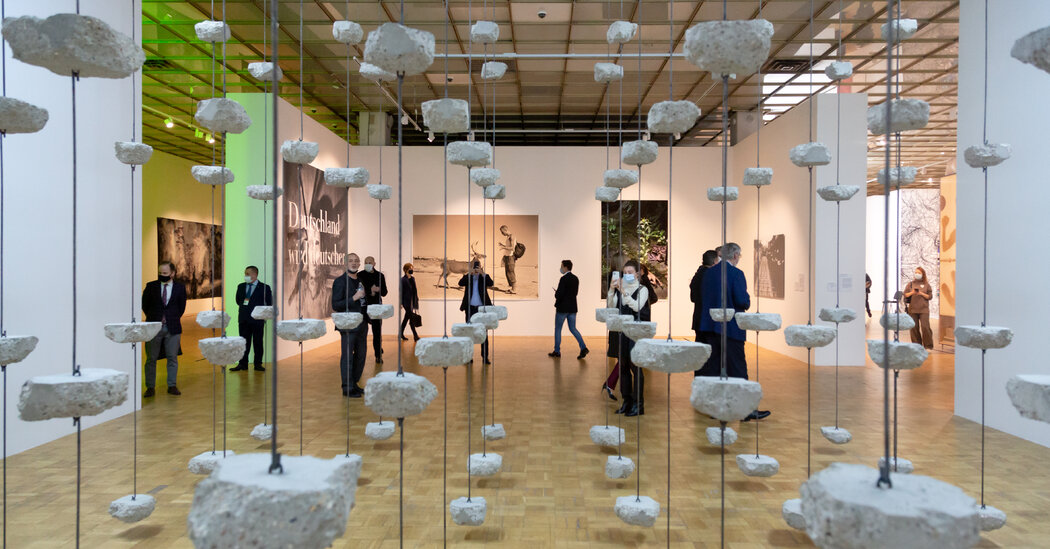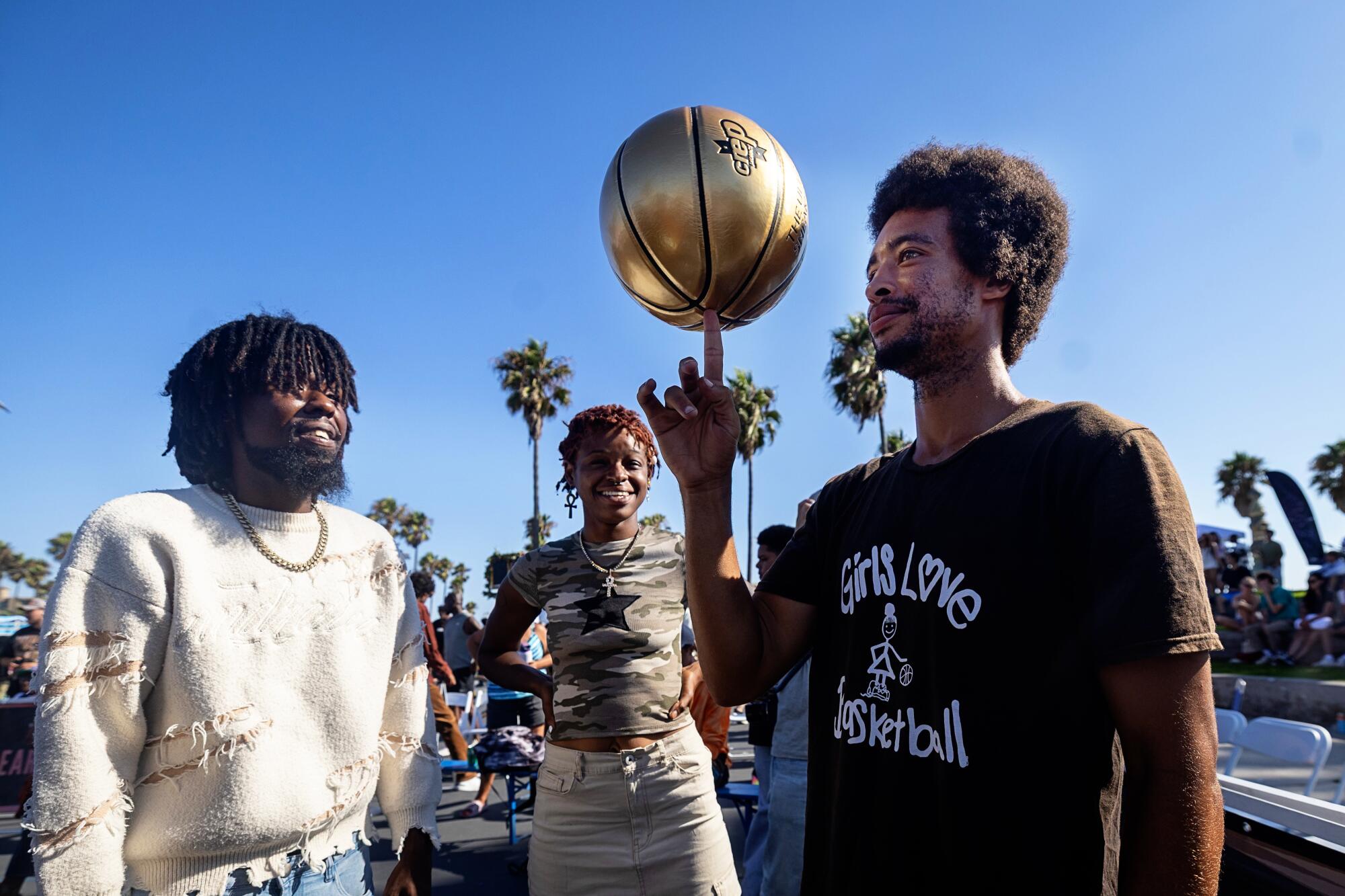
MOSCOW — With tensions building between Russia and the West over Ukraine, the migration crisis in Belarus and rising natural gas prices, it might be a surprise that President Vladimir V. Putin is a patron of an art exhibition celebrating European unity.
But there his name is, displayed on the wall at the entrance to “Diversity United,” an exhibition that arrived in the New Tretyakov Gallery in Moscow on Nov. 23, after a four-month stint at the Tempelhof Airport in Berlin, where it attracted more than 50,000 visitors. The show runs in Moscow through March 13, and then its next scheduled stop is Paris.
President Emmanuel Macron of France and President Frank-Walter Steinmeier of Germany are also patrons of the exhibition, which explores notions of what Europe is. Bringing together works by 90 artists from 34 countries, the show deals with concepts like the transience of borders, migration, historical trauma and much more. Taken together, the art on show adds up to an idealistic picture of a continent united around liberal values, such as political freedom and human rights.
That is not a vision shared by Russia’s government. Even the show’s name exposes crucial differences in perspective: In Russia, the word “diversity” carries none of the connotations it has in the West around the inclusion of marginalized groups.
Yet for the artists involved — from Russia and elsewhere in Europe — the exhibition is a chance to show their work to new audiences that might be difficult to reach otherwise. For the organizers, it is a diplomatic flex, and an opportunity to find common ground during a time of political tension.
The idea for “Diversity United” originated with Walter Smerling, an arts administrator and cultural impresario who is the chairman of the Foundation for Art and Culture, a nonprofit organization based in Bonn, Germany. Several years ago, Smerling organized a large-scale exhibition of German art in Beijing (which drew 750,000 visitors) and of Chinese art in the Rhine and Ruhr regions in Germany.
Afterward, Smerling said in a recent phone interview, he realized he could orchestrate a similar exchange among the nations of Europe. “Russia’s idea of democracy and freedom is a little bit different from the idea of the rest of Europe,” Smerling said. “Art will not change the situation,” he added, “but we can build a basis for dialogue in Moscow.”
Though the French, Russian and German presidents have no official obligations, Steinmeier gave a speech at the show’s opening in Berlin. As for Putin: “We never saw Putin, we never talked to Putin, he never sent us an email,” Smerling said.
Instead, Smerling relied on his partner in Moscow, Zelfira Tregulova, the general director of the State Tretyakov Gallery (to which the New Tretyakov Gallery belongs), to negotiate the terms of the show’s presence in Russia with the government, which oversees the museum.
For Russia, “it’s a P.R. coup to get a major exhibition like this,” said Jane Sharp, an art history professor at Rutgers University with expertise in Russian and Soviet art. “It’s an opportunity for soft diplomacy, for Russia to display its willingness to participate in discussions of heterogeneity and human rights and individual freedoms, but within the context of Europe, which displaces those questions from Russia.”
When a visitor enters the show in the New Tretyakov Gallery, one of the first works they see is a row of colorful maps of Europe by Jan Svenungsson, a Swedish artist. At first glance, the maps seem identical, but a closer look shows the borders of countries shifting with each iteration. At the other end of the room, a video by the French artist Christian Boltanski recombines photographs showing sections of children’s faces from France, Germany and Russia into new composites.
The message is clear: We are all made up of the same fundamental parts. Biologically, that might be true. Yet, Russia has never quite fit into Europe’s politics and culture.
Payam Sharifi, a member of the Slavs and Tatars art collective, whose work appears in “Diversity United,” said that the exhibition’s “elephant in the room” was the question: “Is Russia part of Europe or not?” The answer “is never easy,” he said. “It’s both yes and no.”
Culturally, Russia shares traditions with Europe, but politically, it stands apart, said Ekaterina Muromtseva, a Moscow-based artist whose contribution to the show is a series of watercolors showing protesters holding empty placards. “Our government doesn’t care about human rights at all,” she said.
Tregulova, the Tretyakov director, said that when “Diversity United” went on display in Moscow, she and some of the city’s art critics noticed a trend: The artists from outside Russia tended to tackle issues of the moment — like Brexit, migration, or right-wing movements across the continent — whereas the Russians focused on concepts less connected to current events.
Inclusion and identity are topics that carry a sense of urgency in the West, and which are explored by many artists in “Diversity United,” but do not have similar political implications in Russia: Discussions about fair representation based on race, gender or sexuality have not found a wide audience here.
In Berlin, critics pointed out that despite the show’s name, people involved behind-the-scenes, like the members of the curatorial board, did not reflect the heterogeneity of Europe’s residents. “It is perplexing that all 12 members of the project advisory board belong to the species ‘old white man,’” Ronald Düker wrote in Die Zeit, a German newspaper, in June.
Responding to that criticism in the interview, Smerling said, “When we started, we needed help with making contacts in the economy world, in the political world — because we need support. And, therefore, I asked people I knew.”
“It would be great to have women who could help us,” he added. “But I didn’t find them.”
Ahmet Ogut, a Turkish artist who divides his time between Berlin, Amsterdam and Istanbul, said he withdrew his work and his name from the show on July 12, about one month after the opening in Germany, over several misgivings. “Are we there just for our names,” he said of the artists involved, “or is it really about diversity?”
Similar criticisms have not been raised in mainstream Russian media. But Yelena Kalinsky, an academic at Michigan State University who specializes in modern and contemporary art, said that the curators of “Diversity United” could have provoked some introspection with the right artworks.
“Russia is a multiethnic, multireligious, multilinguistic former empire, and there are artists working on these questions,” Kalinsky said. “But the state itself is not really interested in these things.”
Despite the missed opportunity, Kalinsky said, there was still value in the cultural exchange that this exhibition provides. “It’s not entirely cynical to look at these diplomatic exhibitions and see them as a front for this rosy idea of cooperation — but they also have an effect, which is maintaining contact,” she added.
During the Soviet Union era, when Russia was closed off to the West, there were moments of exchange across the Iron Curtain, including a landmark 1979 exhibition “Paris-Moscow, 1900-1930” that showed in both cities and several exhibitions of Western artists like Francis Bacon, Gilbert & George and Robert Rauschenberg in late-1980s Moscow.
At the end of the day, Kalinsky said, one show will not change everything. But “having contemporary art institutions within Russia and outside of Russia that are actively coming in and working with Russian artists,” she added, “is the most important thing.”







